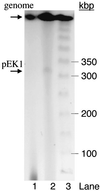Evidence that a linear megaplasmid encodes enzymes of aliphatic alkene and epoxide metabolism and coenzyme M (2-mercaptoethanesulfonate) biosynthesis in Xanthobacter strain Py2
- PMID: 11244054
- PMCID: PMC95121
- DOI: 10.1128/JB.183.7.2172-2177.2001
Evidence that a linear megaplasmid encodes enzymes of aliphatic alkene and epoxide metabolism and coenzyme M (2-mercaptoethanesulfonate) biosynthesis in Xanthobacter strain Py2
Abstract
The bacterial metabolism of propylene proceeds by epoxidation to epoxypropane followed by a sequence of three reactions resulting in epoxide ring opening and carboxylation to form acetoacetate. Coenzyme M (2-mercaptoethanesulfonic acid) (CoM) plays a central role in epoxide carboxylation by serving as the nucleophile for epoxide ring opening and the carrier of the C(3) unit that is ultimately carboxylated to acetoacetate, releasing CoM. In the present work, a 320-kb linear megaplasmid has been identified in the gram-negative bacterium Xanthobacter strain Py2, which contains the genes encoding the key enzymes of propylene oxidation and epoxide carboxylation. Repeated subculturing of Xanthobacter strain Py2 under nonselective conditions, i.e., with glucose or acetate as the carbon source in the absence of propylene, resulted in the loss of the propylene-positive phenotype. The propylene-negative phenotype correlated with the loss of the 320-kb linear megaplasmid, loss of induction and expression of alkene monooxgenase and epoxide carboxylation enzyme activities, and the loss of CoM biosynthetic capability. Sequence analysis of a hypothetical protein (XecG), encoded by a gene located downstream of the genes for the four enzymes of epoxide carboxylation, revealed a high degree of sequence identity with proteins of as-yet unassigned functions in the methanogenic archaea Methanobacterium thermoautotrophicum and Methanococcus jannaschii and in Bacillus subtilis. The M. jannaschii homolog of XecG, MJ0255, is located next to a gene, MJ0256, that has been shown to encode a key enzyme of CoM biosynthesis (M. Graupner, H. Xu, and R. H. White, J. Bacteriol. 182: 4862-4867, 2000). We propose that the propylene-positive phenotype of Xanthobacter strain Py2 is dependent on the selective maintenance of a linear megaplasmid containing the genes for the key enzymes of alkene oxidation, epoxide carboxylation, and CoM biosynthesis.
Figures





Similar articles
-
Heterologous expression of bacterial Epoxyalkane:Coenzyme M transferase and inducible coenzyme M biosynthesis in Xanthobacter strain Py2 and Rhodococcus rhodochrous B276.J Bacteriol. 2000 May;182(9):2629-34. doi: 10.1128/JB.182.9.2629-2634.2000. J Bacteriol. 2000. PMID: 10762269 Free PMC article.
-
Characterization of 2-bromoethanesulfonate as a selective inhibitor of the coenzyme m-dependent pathway and enzymes of bacterial aliphatic epoxide metabolism.J Bacteriol. 2006 Dec;188(23):8062-9. doi: 10.1128/JB.00947-06. Epub 2006 Sep 22. J Bacteriol. 2006. PMID: 16997966 Free PMC article.
-
Shotgun proteomics of Xanthobacter autotrophicus Py2 reveals proteins specific to growth on propylene.Arch Microbiol. 2010 Nov;192(11):945-57. doi: 10.1007/s00203-010-0623-3. Epub 2010 Sep 16. Arch Microbiol. 2010. PMID: 20844868
-
Getting a handle on the role of coenzyme M in alkene metabolism.Microbiol Mol Biol Rev. 2008 Sep;72(3):445-56. doi: 10.1128/MMBR.00005-08. Microbiol Mol Biol Rev. 2008. PMID: 18772284 Free PMC article. Review.
-
Aliphatic epoxide carboxylation.Annu Rev Biochem. 2003;72:55-76. doi: 10.1146/annurev.biochem.72.121801.161820. Epub 2003 Jan 8. Annu Rev Biochem. 2003. PMID: 12524213 Review.
Cited by
-
Involvement of linear plasmids in aerobic biodegradation of vinyl chloride.Appl Environ Microbiol. 2004 Oct;70(10):6092-7. doi: 10.1128/AEM.70.10.6092-6097.2004. Appl Environ Microbiol. 2004. PMID: 15466555 Free PMC article.
-
The pathway for coenzyme M biosynthesis in bacteria.Proc Natl Acad Sci U S A. 2022 Sep 6;119(36):e2207190119. doi: 10.1073/pnas.2207190119. Epub 2022 Aug 29. Proc Natl Acad Sci U S A. 2022. PMID: 36037354 Free PMC article.
-
Coenzyme M biosynthesis in bacteria involves phosphate elimination by a functionally distinct member of the aspartase/fumarase superfamily.J Biol Chem. 2018 Apr 6;293(14):5236-5246. doi: 10.1074/jbc.RA117.001234. Epub 2018 Feb 6. J Biol Chem. 2018. PMID: 29414784 Free PMC article.
-
Cytochrome P450 initiates degradation of cis-dichloroethene by Polaromonas sp. strain JS666.Appl Environ Microbiol. 2013 Apr;79(7):2263-72. doi: 10.1128/AEM.03445-12. Epub 2013 Jan 25. Appl Environ Microbiol. 2013. PMID: 23354711 Free PMC article.
-
Evolutionary analysis by whole-genome comparisons.J Bacteriol. 2002 Apr;184(8):2260-72. doi: 10.1128/JB.184.8.2260-2272.2002. J Bacteriol. 2002. PMID: 11914358 Free PMC article.
References
-
- Allen J R, Ensign S A. Purification to homogeneity and reconstitution of the individual components of the epoxide carboxylase multiprotein enzyme complex from Xanthobacter strain Py2. J Biol Chem. 1997;272:32121–32128. - PubMed
-
- Allen J R, Ensign S A. Two short-chain dehydrogenases confer stereoselectivity for enantiomers of epoxypropane in the multiprotein epoxide carboxylating systems of Xanthobacter strain Py2 and Nocardia Corallina B276. Biochemistry. 1999;38:247–256. - PubMed
-
- Bergeron H, Labbe D, Turmel C, Lau Peter C K. Cloning, sequence and expression of a linear plasmid-based and a chromosomal homolog of chloroacetaldehyde dehydrogenase-encoding genes in Xanthobacter autotrophicus GJ10. Gene. 1998;207:9–18. - PubMed
Publication types
MeSH terms
Substances
Associated data
- Actions
Grants and funding
LinkOut - more resources
Full Text Sources
Miscellaneous


